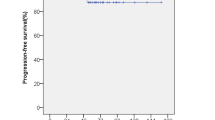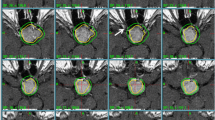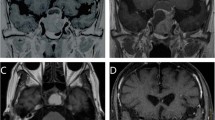Abstract
Purpose
To define the efficacy and complications of multisession Gamma Knife radiosurgery (MGKRS) delivered in three consecutive sessions for the treatment of residual or recurrent pituitary adenomas (PAs).
Methods
This was a retrospective study of data from the Neurosurgery and Gamma Knife Radiosurgery Department at San Raffaele Hospital between May 2008 and September 2017. We recruited 47 consecutive patients undergoing MGKRS in three consecutive fractions for residual or recurrent PA with a distance from the anterior optic pathway inferior to 2–3 mm.
Results
Thirty-eight (80.8%) patients had a nonfunctioning-PA (NFPA) while 9 (19.2%) had a hormone-secreting PA (HSPA). Tumor control was achieved in 100% of patients. Tumor shrinkage was seen in 33 out of 44 (75.0%) patients with a radiological follow-up. Mean tumor volume before MGKRS was 3.93 cm3. The mean tumor volume at last follow-up was 2.11 cm3, with a mean tumor shrinkage of 50.2%, as compared with baseline. One case of suspected radiation-induced optic neuropathy (RION) was documented while new-onset hypopituitarism for any axis occurred in 12 of the 31 (38.7%) patients at risk. The mean follow-up was 44.6 ± 4.0 months (range, 6–111 months).
Conclusions
MGKRS is a valid alternative to external fractionated radiotherapy and other types of stereotactic radiosurgery for the treatment of PAs, achieving a high tumor control rate with a low risk of visual deterioration. Moreover, the majority of patients showed a significant reduction of tumor size in the long term.


Similar content being viewed by others
References
G. Minniti, D.C. Gilbert, M. Brada, Modern techniques for pituitary radiotherapy. Rev. Endocr. Metab. Disord. 10(2), 135–144 (2009). https://doi.org/10.1007/s11154-008-9106-0
J.P. Sheehan, A. Niranjan, J.M. Sheehan, J.A. Jane Jr., E.R. Laws, D. Kondziolka, J. Flickinger, A.M. Landolt, J.S. Loeffler, L.D. Lunsford, Stereotactic radiosurgery for pituitary adenomas: an intermediate review of its safety, efficacy, and role in the neurosurgical treatment armamentarium. J. Neurosurg. 102(4), 678–691 (2005). https://doi.org/10.3171/jns.2005.102.4.0678
J.S. Loeffler, H.A. Shih, Radiation therapy in the management of pituitary adenomas. J. Clin. Endocrinol. Metab. 96(7), 1992–2003 (2011). https://doi.org/10.1210/jc.2011-0251
M. Losa, M. Valle, P. Mortini, A. Franzin, C.F. da Passano, M. Cenzato, S. Bianchi, P. Picozzi, M. Giovanelli, Gamma knife surgery for treatment of residual nonfunctioning pituitary adenomas after surgical debulking. J. Neurosurg. 100(3), 438–444 (2004). https://doi.org/10.3171/jns.2004.100.3.0438
M. Losa, L. Gioia, P. Picozzi, A. Franzin, M. Valle, M. Giovanelli, P. Mortini, The role of stereotactic radiotherapy in patients with growth hormone-secreting pituitary adenoma. J. Clin. Endocrinol. Metab. 93(7), 2546–2552 (2008). https://doi.org/10.1210/jc.2008-0135
J.P. Sheehan, R.M. Starke, D. Mathieu, B. Young, P.K. Sneed, V.L. Chiang, J.Y. Lee, H. Kano, K.J. Park, A. Niranjan, D. Kondziolka, G.H. Barnett, S. Rush, J.G. Golfinos, L.D. Lunsford, Gamma Knife radiosurgery for the management of nonfunctioning pituitary adenomas: a multicenter study. J. Neurosurg. 119(2), 446–456 (2013). https://doi.org/10.3171/2013.3.JNS12766
B.E. Pollock, P.D. Brown, T.B. Nippoldt, W.F. Young Jr., Pituitary tumor type affects the chance of biochemical remission after radiosurgery of hormone-secreting pituitary adenomas. Neurosurgery 62(6), 1271–1276 (2008). https://doi.org/10.1227/01.neu.0000333298.49436.0e. discussion 1276–1278
F. Castinetti, M. Nagai, I. Morange, H. Dufour, P. Caron, P. Chanson, C. Cortet-Rudelli, J.M. Kuhn, B. Conte-Devolx, J. Regis, T. Brue, Long-term results of stereotactic radiosurgery in secretory pituitary adenomas. J. Clin. Endocrinol. Metab. 94(9), 3400–3407 (2009). https://doi.org/10.1210/jc.2008-2772
C.A. Girkin, C.H. Comey, L.D. Lunsford, M.L. Goodman, L.B. Kline, Radiation optic neuropathy after stereotactic radiosurgery. Ophthalmology 104(10), 1634–1643 (1997). https://doi.org/10.1016/s0161-6420(97)30084-0
J.A. Leavitt, S.L. Stafford, M.J. Link, B.E. Pollock, Long-term evaluation of radiation-induced optic neuropathy after single-fraction stereotactic radiosurgery. Int. J. Radiat. Oncol. Biol. Phys. 87(3), 524–527 (2013). https://doi.org/10.1016/j.ijrobp.2013.06.2047
P. Doroslovacki, M.A. Tamhankar, G.T. Liu, K.S. Shindler, G.S. Ying, M. Alonso-Basanta, Factors associated with occurrence of radiation-induced optic neuropathy at “safe” radiation dosage. Semin. Ophthalmol. 33(4), 581–588 (2018). https://doi.org/10.1080/08820538.2017.1346133
P. Puataweepong, M. Dhanachai, A. Hansasuta, S. Dangprasert, C. Sitathanee, R. Ruangkanchanasetr, P. Yongvithisatid, Clinical outcomes of perioptic tumors treated with hypofractionated stereotactic radiotherapy using CyberKnife(R) stereotactic radiosurgery. J. Neurooncol. 139(3), 679–688 (2018). https://doi.org/10.1007/s11060-018-2913-6
H.I. Liao, C.C. Wang, K.C. Wei, C.N. Chang, Y.H. Hsu, S.T. Lee, Y.C. Huang, H.C. Chen, P.W. Hsu, Fractionated stereotactic radiosurgery using the Novalis system for the management of pituitary adenomas close to the optic apparatus. J. Clin. Neurosci. 21(1), 111–115 (2014). https://doi.org/10.1016/j.jocn.2013.03.024
B.D. Killory, J.J. Kresl, S.D. Wait, F.A. Ponce, R. Porter, W.L. White, Hypofractionated CyberKnife radiosurgery for perichiasmatic pituitary adenomas: early results. Neurosurgery 64(2 Suppl.), A19–A25 (2009). https://doi.org/10.1227/01.NEU.0000341630.42160.18
H. Iwata, K. Sato, K. Tatewaki, N. Yokota, M. Inoue, Y. Baba, Y. Shibamoto, Hypofractionated stereotactic radiotherapy with CyberKnife for nonfunctioning pituitary adenoma: high local control with low toxicity. Neuro. Oncol. 13(8), 916–922 (2011). https://doi.org/10.1093/neuonc/nor055
E. McTyre, C.A. Helis, M. Farris, L. Wilkins, D. Sloan, W.H. Hinson, J.D. Bourland, W.A. Dezarn, M.T. Munley, K. Watabe, F. Xing, A.W. Laxton, S.B. Tatter, M.D. Chan, Emerging indications for fractionated gamma knife radiosurgery. Neurosurgery 80(2), 210–216 (2017). https://doi.org/10.1227/NEU.0000000000001227
G. Minniti, J. Flickinger, B. Tolu, S. Paolini, Management of nonfunctioning pituitary tumors: radiotherapy. Pituitary 21(2), 154–161 (2018). https://doi.org/10.1007/s11102-018-0868-4
M. Losa, G. Spatola, L. Albano, A. Gandolfi, A. Del Vecchio, A. Bolognesi, P. Mortini, Frequency, pattern, and outcome of recurrences after gamma knife radiosurgery for pituitary adenomas. Endocrine 56(3), 595–602 (2017). https://doi.org/10.1007/s12020-016-1081-8
M. Torrens, C. Chung, H.T. Chung, P. Hanssens, D. Jaffray, A. Kemeny, D. Larson, M. Levivier, C. Lindquist, B. Lippitz, J. Novotny Jr., I. Paddick, D. Prasad, C.P. Yu, Standardization of terminology in stereotactic radiosurgery: Report from the Standardization Committee of the International Leksell Gamma Knife Society: special topic. J. Neurosurg. 121(Suppl.), 2–15 (2014). https://doi.org/10.3171/2014.7.GKS141199
G. Sicignano, M. Losa, A. del Vecchio, G.M. Cattaneo, P. Picozzi, A. Bolognesi, P. Mortini, R. Calandrino, Dosimetric factors associated with pituitary function after Gamma Knife Surgery (GKS) of pituitary adenomas. Radiother. Oncol. 104(1), 119–124 (2012). https://doi.org/10.1016/j.radonc.2012.03.021
J.W. Kim, Y.S. Im, D.H. Nam, K. Park, J.H. Kim, J.I. Lee, Preliminary report of multisession gamma knife radiosurgery for benign perioptic lesions: visual outcome in 22 patients. J. Korean Neurosurg. Soc. 44(2), 67–71 (2008). https://doi.org/10.3340/jkns.2008.44.2.67
T.K. Jee, H.J. Seol, Y.S. Im, D.S. Kong, D.H. Nam, K. Park, H.J. Shin, J.I. Lee, Fractionated gamma knife radiosurgery for benign perioptic tumors: outcomes of 38 patients in a single institute. Brain Tumor Res. Treat. 2(2), 56–61 (2014). https://doi.org/10.14791/btrt.2014.2.2.56
J.H. Nguyen, C.J. Chen, C.C. Lee, C.P. Yen, Z. Xu, D. Schlesinger, J.P. Sheehan, Multisession gamma knife radiosurgery: a preliminary experience with a noninvasive, relocatable frame. World Neurosurg. 82(6), 1256–1263 (2014). https://doi.org/10.1016/j.wneu.2014.07.042
J.W. Snell, J. Sheehan, M. Stroila, L. Steiner, Assessment of imaging studies used with radiosurgery: a volumetric algorithm and an estimation of its error. Tech. Note J. Neurosurg. 104(1), 157–162 (2006). https://doi.org/10.3171/jns.2006.104.1.157
P. Puataweepong, M. Dhanachai, A. Hansasuta, S. Dangprasert, T. Swangsilpa, C. Sitathanee, C. Jiarpinitnun, P. Vitoonpanich, P. Yongvithisatid, The clinical outcome of hypofractionated stereotactic radiotherapy with cyberknife robotic radiosurgery for perioptic pituitary adenoma. Technol. Cancer Res. Treat. 15(6), NP10–NP15 (2016). https://doi.org/10.1177/1533034615607113
D. Kondziolka, S. Somaza, C. Comey, L.D. Lunsford, D. Claassen, S. Pandalai, A. Maitz, J.C. Flickinger, Radiosurgery and fractionated radiation therapy: comparison of different techniques in an in vivo rat glioma model. J. Neurosurg. 84(6), 1033–1038 (1996). https://doi.org/10.3171/jns.1996.84.6.1033
R.M. Starke, B.J. Williams, J.A. Jane Jr., J.P. Sheehan, Gamma Knife surgery for patients with nonfunctioning pituitary macroadenomas: predictors of tumor control, neurological deficits, and hypopituitarism. J. Neurosurg. 117(1), 129–135 (2012). https://doi.org/10.3171/2012.4.JNS112250
R. Attanasio, P. Epaminonda, E. Motti, E. Giugni, L. Ventrella, R. Cozzi, M. Farabola, P. Loli, P. Beck-Peccoz, M. Arosio, Gamma-knife radiosurgery in acromegaly: a 4-year follow-up study. J. Clin. Endocrinol. Metab. 88(7), 3105–3112 (2003). https://doi.org/10.1210/jc.2002-021663
G.C. Feigl, C.M. Bonelli, A. Berghold, M. Mokry, Effects of gamma knife radiosurgery of pituitary adenomas on pituitary function. J. Neurosurg. 97(5 Suppl.), 415–421 (2002). https://doi.org/10.3171/jns.2002.97.supplement
C. Hoybye, E. Grenback, T. Rahn, M. Degerblad, M. Thoren, A.L. Hulting, Adrenocorticotropic hormone-producing pituitary tumors: 12- to 22-year follow-up after treatment with stereotactic radiosurgery. Neurosurgery 49(2), 284–291 (2001). discussion 291–282
K.J. Park, H. Kano, P.V. Parry, A. Niranjan, J.C. Flickinger, L.D. Lunsford, D. Kondziolka, Long-term outcomes after gamma knife stereotactic radiosurgery for nonfunctional pituitary adenomas. Neurosurgery 69(6), 1188–1199 (2011). https://doi.org/10.1227/NEU.0b013e318222afed
A.C. van den Bergh, G. van den Berg, M.A. Schoorl, W.J. Sluiter, A.M. van der Vliet, E.W. Hoving, B.G. Szabo, J.A. Langendijk, B.H. Wolffenbuttel, R.P. Dullaart, Immediate postoperative radiotherapy in residual nonfunctioning pituitary adenoma: beneficial effect on local control without additional negative impact on pituitary function and life expectancy. Int. J. Radiat. Oncol. Biol. Phys. 67(3), 863–869 (2007). https://doi.org/10.1016/j.ijrobp.2006.09.049
G. Minniti, M. Osti, M.L. Jaffrain-Rea, V. Esposito, G. Cantore, R. Maurizi Enrici, Long-term follow-up results of postoperative radiation therapy for Cushing’s disease. J. Neurooncol. 84(1), 79–84 (2007). https://doi.org/10.1007/s11060-007-9344-0
M.T. Milano, J. Grimm, S.G. Soltys, E. Yorke, V. Moiseenko, W.A. Tome, A. Sahgal, J. Xue, L. Ma, T.D. Solberg, J.P. Kirkpatrick, L.S. Constine, J.C. Flickinger, L.B. Marks, I. El Naqa, Single- and multi-fraction stereotactic radiosurgery dose tolerances of the optic pathways. Int. J. Radiat. Oncol. Biol. Phys. (2018). https://doi.org/10.1016/j.ijrobp.2018.01.053
Author information
Authors and Affiliations
Corresponding author
Ethics declarations
Conflict of interest
The authors declare that they have no conflict of interest.
Ethical standards
All procedures were in accordance with the ethical standards of the institutional research committee and with the 1964 Helsinki Declaration and its later amendments or comparable ethical standards.
Informed consent
Standard informed consent was obtained from each patient undergoing gamma knife treatment.
Additional information
Publisher’s note: Springer Nature remains neutral with regard to jurisdictional claims in published maps and institutional affiliations.
Rights and permissions
About this article
Cite this article
Albano, L., Losa, M., Nadin, F. et al. Safety and efficacy of multisession gamma knife radiosurgery for residual or recurrent pituitary adenomas. Endocrine 64, 639–647 (2019). https://doi.org/10.1007/s12020-019-01876-2
Received:
Accepted:
Published:
Issue Date:
DOI: https://doi.org/10.1007/s12020-019-01876-2




